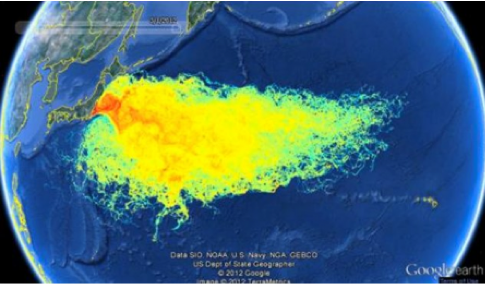Search
Democracy Links
Member's Off-site Blogs
forget the boats ....

A radioactive plume of water in the Pacific Ocean from Japan's Fukushima nuclear plant, which was crippled in the 2011 earthquake and tsunami, will likely reach U.S. coastal waters starting in 2014, according to a new study. The long journey of the radioactive particles could help researchers better understand how the ocean’s currents circulate around the world.
Ocean simulations showed that the plume of radioactive cesium-137 released by the Fukushima disaster in 2011 could begin flowing into U.S. coastal waters starting in early 2014 and peak in 2016. Luckily, two ocean currents off the eastern coast of Japan — the Kuroshio Current and the Kuroshio Extension — would have diluted the radioactive material so that its concentration fell well below the World Health Organization’s safety levels within four months of the Fukushima incident. But it could have been a different story if nuclear disaster struck on the other side of Japan.
“The environmental impact could have been worse if the contaminated water would have been released in another oceanic environment in which the circulation was less energetic and turbulent,” said Vincent Rossi, an oceanographer and postdoctoral research fellow at the Institute for Cross-Disciplinary Physics and Complex Systems in Spain.
Fukushima’s radioactive water release has taken its time journeying across the Pacific. By comparison, atmospheric radiation from the Fukushima plant began reaching the U.S. West Coast within just days of the disaster back in 2011. [Fukushima Radiation Leak: 5 Things You Should Know]
Tracking radioactivity’s path
The radioactive plume has three different sources: radioactive particles falling out from the atmosphere into the ocean, contaminated water directly released from the plant, and water that became contaminated by leaching radioactive particles from tainted soil.
The release of cesium-137 from Fukushima in Japan’s more turbulent eastern currents means the radioactive material is diluted to the point of posing little threat to humans by the time it leaves Japan’s coastal waters. Rossi worked with former colleagues at the Climate Change Research Centre at the University of New South Wales in Australia to simulate the spread of Fukushima’s radioactivity in the oceans — a study detailed in the October issue of the journal Deep-Sea Research Part 1.
Researchers averaged 27 experimental runs of their model — each run starting in a different year — to ensure that the simulated spread of the cesium-137 as a "tracer" was not unusually affected by initial ocean conditions. Many oceanographers studying the ocean’s currents prefer using cesium-137 to track the ocean currents because it acts as a passive tracer in seawater, meaning it doesn't interact much with other things, and decays slowly with a long half-life of 30 years.
“One advantage of this tracer is its long half-life and our ability to measure it quite accurately, so that it can be used in the future to test our models of ocean circulation and see how well they represent reality over time,” Rossi told LiveScience. “In 20 years' time, we could go out, grab measurements everywhere in the Pacific and compare them to our model.”
Journey across the Pacific Rim
The team focused on predicting the path of the radioactivity until it reached the continental shelf waters stretching from the U.S. coastline to about 180 miles (300 kilometers) offshore. About 10 to 30 becquerels (units of radioactivity representing decay per second) per cubic meter of cesium-137 could reach U.S. and Canadian coastal waters north of Oregon between 2014 and 2020. (Such levels are far below the U.S. Environmental Protection Agency’s limits for drinking water.)
By comparison, California’s coast may receive just 10 to 20 becquerels per cubic meter from 2016 to 2025. That slower, lesser impact comes from Pacific currents taking part of the radioactive plume down below the ocean surface on a slower journey toward the Californian coast, Rossi explained.
A large proportion of the radioactive plume from the initial Fukushima release won't even reach U.S. coastal waters anytime soon. Instead, the majority of the cesium-137 will remain in the North Pacific gyre — a region of ocean that circulates slowly clockwise and has trapped debris in its center to form the “Great Pacific Garbage Patch” — and continue to be diluted for approximately a decade following the initial Fukushima release in 2011. (The water from the current power plant leak would be expected to take a similar long-term path to the initial plume released, Rossi said.)
But the plume will eventually begin to escape the North Pacific gyre in an even more diluted form. About 25 percent of the radioactivity initially released will travel to the Indian Ocean and South Pacific over two to three decades after the Fukushima disaster, the model showed.
Fukushima’s Radioactive Ocean Plume To Reach US Waters By 2014
- By John Richardson at 7 Sep 2013 - 3:41pm
- John Richardson's blog
- Login or register to post comments
Recent comments
17 hours 37 min ago
18 hours 47 min ago
19 hours 20 min ago
19 hours 27 min ago
19 hours 31 min ago
19 hours 49 min ago
20 hours 18 min ago
20 hours 44 min ago
22 hours 22 min ago
22 hours 31 min ago